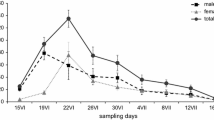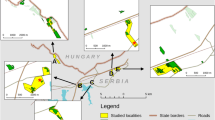Abstract
Surveys of relative abundance were made in DDT-treated and untreated woodland in NW Zimbabwe using playback of tape recorded song. Chats were common in old stands of untreated mopane (Colophospermum mopane) and miombo (Brachystegia spp.) woodland but were less common in suitable habitat which had been sprayed with DDT at the rate of about 200 g ha−1 for tsetse fly control. Population changes in the Siabuwa Communal Area were related to spraying operations over 3.5 years from July 1987 to January 1991. In the 1987–89 treatment area, numbers fell by 88% over 33 months following first treatment, mainly due to a reduction in occupied sites. Groups were smaller and single sex groups more frequent in treated areas compared with an adjacent unsprayed area. Numbers in the unsprayed area fell by 13% over the same period. Total numbers and number of groups at the edge and just within the treated area increased temporarily after each of the first two sprays. At the end of the study, numbers in the 1987 and 1987–89 treatment areas were increasing, and isolated groups were found in the 1984–89 treatment area. In a second study area, a further treatment of DDT, one year after the first, was followed by a 74% decline in numbers over nine months. It is concluded that tsetse spraying operations have had a severe, and possibly prolonged, impact on the White-headed Black Chat population of NW Zimbabwe.
Similar content being viewed by others
References
Allsopp, R. and Hursey, B.S. (1986)Integrated Chemical Control of Tsetse Flies (Glossinaspp.)in Western Zimbabwe 1984–1985. Harare: Irwin Press, for the Tsetse and Trypanosomiasis Control Branch.
Benson, C.W., Brooke, R.K., Dowsett, R.J. and Irwin, M.P.S. (1971)The Birds of Zambia. Glasgow: Collins.
Coulson, I.C. (1989) Elephants and vegetation in the Sengwa Wildlife Research Area. In R.B. Martin, G.C. Craig and V.R. Booth (eds).Elephant Management in Zimbabwe, pp. 51–7. Harare, Causeway: Department of National Parks and Wild Life Management.
Cramp, S. and Conder, P.J. (1961)The Deaths of Birds and Mammals Connected with Toxic Chemicals in the First Half of 1960. Report no. 1 of the BTO-RSPB Committee on Toxic Chemicals. London: RSPB.
Cramp, S., Conder, P.J. and Ash, J.S. (1962)Deaths of Birds and Mammals from Toxic Chemicals, January–June 1961.Second report of the Joint Committee on Toxic Chemicals. Sandy, UK: RSPB.
Cumming, D.H.M. (1981) The management of elephant and other large mammals in Zimbabwe. In P.A. Jewell, S. Holt and D. Hart (eds).Problems in Management of Locally Abundant Wild Mammals. London: Academic Press.
Douthwaite, R.J. (1980) Occurrence of birds in Acacia woodland in northern Botswana related to endosulfan sprayed for tsetse fly control.Environmental Pollution 22, 273–9.
Douthwaite, R.J. (1982) Changes in Pied Kingfisher (Ceryle rudis) feeding related to endosulfan pollution from tsetse fly control operations in the Okavango Delta, Botswana.Journal of Applied Ecology 19, 133–41.
Douthwaite, R.J. (1986) Effects of drift sprays of endosulfan, applied for tsetse fly control, on breeding Little Bee-eaters in Somalia.Environmental Pollution, Series A 41, 11–22.
Douthwaite, R.J. and Tingle, C.C.D. (eds.) (1992)Effects of DDT applied for tsetse fly control on White-headed Black Chat (Thamnolea arnoti) populations in Zimbabwe. Part II: cause of decline.Ecotoxicology (in press).
Garcia, E.F.J. (1983) An experimental test of competition for space between blackcapsSylvia atricapilla and garden warblerSylvia borin in the breeding season.Journal of Animal Ecology 52, 795–806.
Gillard, L. (1987)Southern African Bird Calls. Johannesburg: Gillard Bird Cassettes.
Henny, C.J. (1972)An Analysis of the Population Dynamics of Selected Avian Species. Washington DC: US Department of the Interior.
Hensley, M.M. and Cope, J.B. (1951) Further data on removal and repopulation of the breeding birds in a spruce-fir forest community.Auk 68, 483–93.
Hickey, J.J. and Hunt, L.B. (1960a) Initial songbird mortality following a Dutch Elm disease control program.Journal of Wildlife Management 24, 259–65.
Hickey, J.J. and Hunt, L.B. (1960b) Songbird mortality following annual programs to control Dutch Elm disease.Atlantic Naturalist 15, 87–92.
Hotchkiss, N. and Pough, R.H. (1946). Effect on forest birds of DDT used for Gypsy Moth Control in Pennsylvania.Journal of Wildlife Management 10, 202–7.
Hunt, L.B. (1960) Songbird breeding populations in DDT-sprayed Dutch Elm disease communities.Journal of Wildlife Management 24, 139–46.
Jacobsen, N.H.G. (1979) Birds of the Sengwa Wildlife Research Area, Zimbabwe-Rhodesia.Southern Birds,6. Benmore: Witwatersrand Bird Club.
Jakobsson, S. (1988) Territorial fidelity of willow warbler (Phylloscopus trochilus) males and success in competition over territories.Behavioral Ecology and Sociobiology 22, 79–84.
Krebs, J.R. (1982) Territorial defence in the Great Tit (Parus major): do residents always win?Behavioral Ecology and Sociobiology 11, 185–94.
Lambert, M.R.K., Grant, I.F., Smith, C.L., Tingle, C.C.D. and Douthwaite, R.J. (1991)Effects of Deltamethrin Ground-Spraying on Non-target Wildlife. Environmental Impact of Ground-Spraying Operations against Tsetse Fly in Zimbabwe. Technical Report No. 1. Chatham, UK: Natural Resources Institute.
Maasdorp, R.A.C. and Zyl, M. van. (1987) Possible side-effects of insecticides.Honeyguide 33, 154.
Marchant, J.H., Hudson, R., Carter, S.P. and Whittington, P. (1990)Population Trends in British Breeding Birds. Tring: British Trust for Ornithology.
Mehner, J.F. and Wallace, G.J. (1959) Robin populations and insecticides.Atlantic Naturalist 14, 4–10.
Murindagomo, F. (1989) Rates of tree loss and regrowth of Brachystegia woodland. In R.B. Martin, G.C. Craig and V.R. Booth (eds).Elephant Management in Zimbabwe, p. 65. Harare, Causeway: Department of National Parks and Wild Life Management.
Newton, I. (1979)Population Ecology of Raptors, Berkhamsted: Poyser.
O'Connor, R.J. (1991) Long-term bird population studies in the United States.Ibis 133 (suppl. 1), 36–48.
Parnell, G. (1971) Letter to the Editor.Honeyguide 65, 44.
Stewart, R.E. and Aldrich, J.W. (1951). Removal and repopulation of breeding birds in a sprucefir forest community.Auk 68, 471–82.
Wallace, G.J., Nickell, W.P. and Bernard, R.F. (1961)Bird Mortality in the Dutch Elm Disease Program in Michigan. Bulletin 41. Bloomfield Hills, Michigan: Cranbrook Institute of Science.
Wurster, C.F., Wurster, D.H. and Strickland, W.N. (1965) Bird mortality after spraying for Dutch Elm disease with DDT.Science 148, 90–1.
Author information
Authors and Affiliations
Rights and permissions
About this article
Cite this article
Douthwaite, R.J. Effects of DDT treatments applied for tsetse fly control on White-headed Black Chat (Thamnolaea arnoti) populations in Zimbabwe. Part I: population changes. Ecotoxicology 1, 17–30 (1992). https://doi.org/10.1007/BF00702653
Received:
Accepted:
Issue Date:
DOI: https://doi.org/10.1007/BF00702653




